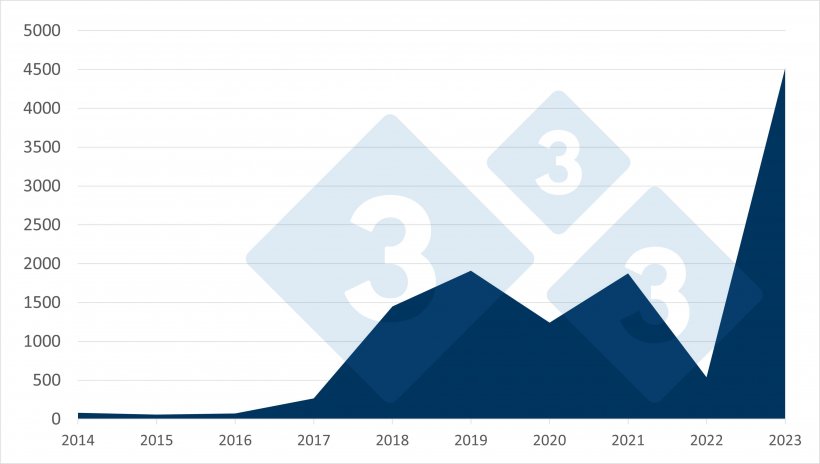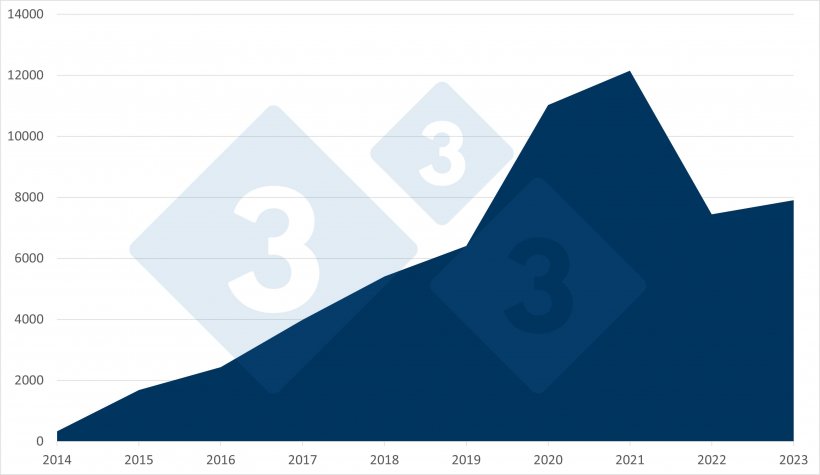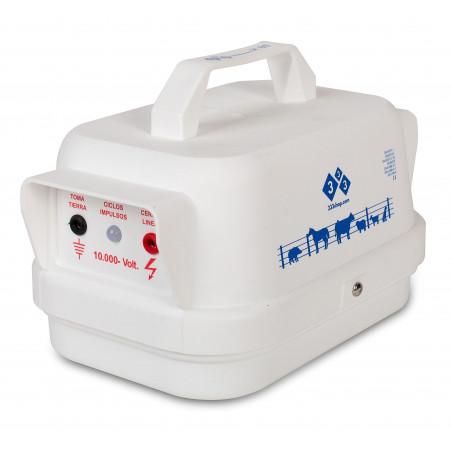We present data updated through 2023 on the evolution of African swine fever (ASF) in the different European countries that have confirmed the presence of the disease in both domestic pigs and wild boar since the first notification in 2014 (Figures 1 and 3) as well as the total annual outbreaks (Figures 2 and 4).
In 2023, the disease reappeared in the Czech Republic and Greece and was confirmed for the first time in Bosnia-Herzegovina, Croatia, Kosovo, and in September in Sweden.

Domestic pigs
Regarding the disease in domestic pigs in 2023, we highlight that Serbia, which confirmed the presence of the disease for the first time in 2019, has gone from 33 outbreaks in 2021 and 107 in 2022 to 991 in 2023 (an increase of more than 800%).
The number of cases in Romania doubled in 2023 following a dramatic decrease in 2022 when outbreaks went from more than 1,600 to 329. In 2023, 740 outbreaks were confirmed. Cases are widely distributed throughout the country.
Estonia confirmed its first cases in 2015 and had no further cases between 2018 and 2020. The country confirmed the reoccurrence with one outbreak in 2021, saw none in 2022, and reported 2 outbreaks in 2023, one of them on a farm with 9,282 susceptible animals in the Polva region.
Poland, which managed to reduce the number of outbreaks from 124 in 2021 to just 14 in 2022, confirmed 30 outbreaks in 2023.
Slovakia did not have any outbreaks of the disease in domestic pigs last year.
Greece reported 6 outbreaks after two years without the disease in domestic pigs.
Special mention should be made of Croatia and Bosnia and Herzegovina, which reported the disease for the first time last year. In the case of Croatia, the presence of the disease was detected for the first time in June 2023 with the confirmation of 2 outbreaks in domestic pigs in the region of Drenovci and since then a total of 1,124 outbreaks have been reported, the vast majority on commercial farms. In Bosnia and Herzegovina, the disease was detected for the first time in June 2023 with the confirmation of an outbreak in domestic pigs in the region of Bijeljina and since then, 1,508 outbreaks have been reported, all of them located in the north of the country, close to the borders with Croatia and Serbia.
Figure 1. Evolution of ASF outbreaks in domestic pigs in European countries (2014-2023). Source: 333 based on ADIS data. Remember that these graphs are interactive and allow you to visualize the number of outbreaks (Score) or ranking (Ranks) for a given country or year.
We see that the total number of outbreaks skyrocketed in 2023, albeit largely due to the emergence of the disease in Bosnia-Herzegovina and Croatia, Romania and Serbia also contributed to this increase of more than 700% over the previous year, from 537 total outbreaks in 2022 to 4,513 in 2023.

Figure 2. Total outbreaks of ASF in domestic pigs (2014-2023). Source: 333 based on ADIS data.
Wild boar
On June 27, 2017, ASF was confirmed for the first time in the Czech Republic, and after 3 years without any cases and only one case in 2022, last year the country confirmed 56 outbreaks in wild boar, all of them in the same region, close to the borders with Germany and Poland.
In Italy, ASF is considered endemic on the island of Sardinia and had never before appeared in mainland Italy until January 2022, when it was confirmed in a wild boar found dead in the Piedmont region. Then there was a significant jump with the confirmation of the disease in wild boar in the metropolitan area of the city of Rome in June 2022, about 400 km from the affected area in the northwest of the country. In 2023, there was a new geographical jump, this time to 800 km, appearing in Calabria, and then confirmed in Campania and Calabria. During the past year, 1,047 outbreaks were confirmed in wild boar, tripling the number of outbreaks compared to the previous year.
Germany, since the onset of the disease in 2020 and after the peak of outbreaks in 2021 with more than 2,500, ended 2023 with 899 confirmed outbreaks.
Last September 2023, Sweden confirmed the appearance of ASF for the first time in the country, affecting only wild boar, ending the year with a total of 60 outbreaks.
In Bosnia and Herzegovina and Croatia, while the number of outbreaks in domestic pigs is very high, 22 and 11 outbreaks have been reported in wild boar, respectively.
Figure 3. Evolution of ASF outbreaks in wild boar in European countries (2014-2023). Source: 333 based on ADIS data. Remember that these graphs are interactive and allow you to visualize the number of outbreaks (Score) or ranking (Ranks) for a given country or year.
Regarding the annual evolution of the total number of outbreaks in wild boar, last year a slight increase of 6% was detected compared to the previous year, mainly due to the significant increase in the number of cases in Italy (1,047 in 2023 vs. 277 in 2022).

Figure 4. Total outbreaks of ASF in wild boar (2014-2023). Source: 333 based on ADIS data.
January 18, 2024/ 333 Staff with data from ADIS and MAPA.










